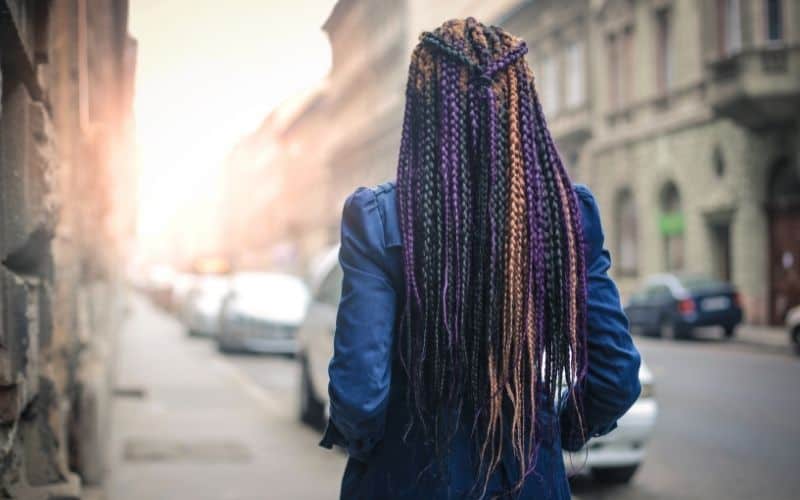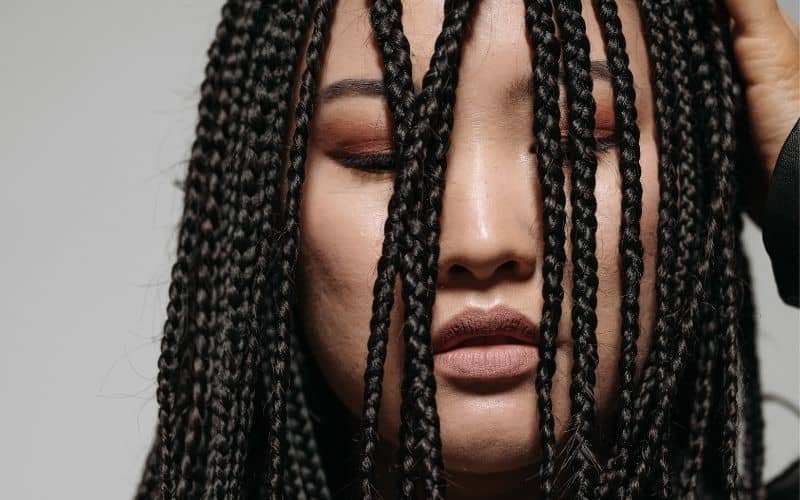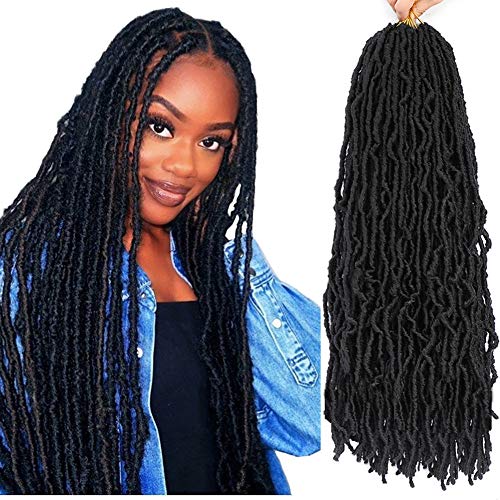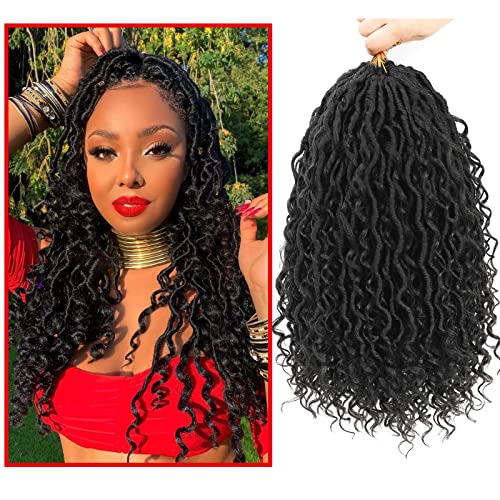The latest style to take over the natural hair world is soft locs and distressed locs. It’s easy to see why this trend has been catching on; both styles give off a bohemian vibe that can be sexy or carefree depending on how you wear them!
The less tension an individual has when dealing with their own personal assets like ours, the better – which makes these two hairstyles perfect for those looking not only beautiful but also stress-free as well. And if all else fails? You’ll get faux locs in half of the time period it normally takes to install real ones!
Yay or Nay?
You decide! You’ve seen the trending photos on Instagram and have been waiting for your turn to try them. Before you do, there are a few things that you should know about this hairstyle.
Firstly, the upkeep could be time-consuming if not done regularly. Secondly, these styles may initially feel heavy depending on how much hair is used – but softened with added oils, they will hang lighter over time.
There’s no hiding from locs once they come in because unlike crochet braids or sew-ins which can easily be taken down and packed away until next time. Once all your hair is “locked”, it becomes permanent until all of your hair has grown out (or trimmed). That said, if you’re still game to try it out, here’s what you need to know.

More: WINTER SKIN CARE TIPS – HOW TO PREVENT WINTER DRY SKIN – SKIN AND BODY CARE IN WINTER
Quick Guide: Soft Locs / Distressed locs
What is it?
This style is essentially just two strand twist on damp hair that would unravel into loose spirals over time (not unlike dreadlocks). The difference between soft locs and distressed locs is how they are installed. While both styles require twisting the hair with gel or cream, soft locks use less tension than distressed, which gives off a smoother appearance. Also, sometimes you need a flat iron for Afro hair to get these styles.
Soft Locs
This style can be achieved with any type of hair! If you have coarse or resistant hair, using a softer texture will allow the twists to come undone more easily once dry. You may also want to look for a less dense alternative if you are light-handed when it comes to your daily products – so that the weight of your natural strands won’t cause too much tension on the twist.
Distressed Locs
The key here is durability. Because this style requires twisting tighter than soft locs, it’s important that your chosen texture has some memory!
Any kinky curly patterned textures should do just fine but for those who struggle to find their ideal density, try braid extensions. The added braids will make the style feel heavier but will also make it more durable.
Crochet Locs
Crochet locs are faux loc extensions – but unlike some other forms of faux locs, crochet locs are sewn onto an individual’s hair, beginning with a cornrow base. The difference lies in the installation process.
Crochet loc extensions start by braiding the hair beneath while adding the synthetic hair into the same braid. This creates a more secure fit for your new locks without having to worry about them slipping off or tangling within weeks!
Faux Locs
The good news about faux locs is that they can be a great alternative for those looking for a low-maintenance style. Unlike the two styles discussed before, faux locs do not have to be done over time!
The synthetic hair comes in pre-braided strands with added roots and tips for a more natural look. However, these strands are heavy, so wearing too many could cause some serious stiffness as well as discomfort – try complementing them with your own natural hairs instead of braiding all of it at once.
How much do soft locs cost?
- Hair style: soft butterfly locs crochet hair synthetic fiber hair, fashion elements center on this butterfly locs crochet hair
- Hair features: handmade braiding short butterfly locs crochet hair, we are professionally and specially weave the hair end and it is not easy to fall apart, so long-last, install it directly, save more time & money, easy to air dry naturally and no tangled
- Hair detail: 1 pack 12 inch, 95g/pack, 12 strands/pc, combine freely, DIY your hairstyle
- Hair advantage: soft, lightweight, tangle-free, shedding-free, no smell, natural stylish looking
- Butterfly crochet locs : suitable for any occasion and season
- 💥1.Hair Material:New faux locs crochet hair used High Quality Low Temperature Kanekalon Fiber,No smell,friendly to skin,african roots dreadlocs crochet braids hair.
More: 8 ESSENTIAL MAKE-UP MUST-HAVES FOR THE ON-THE-GO GAL!
Tips for installing soft locs
– It’s important to relax or condition your hair before attempting any of these styles – as they involve a lot of manipulation and twisting, having healthy moisture will help you achieve the best results.
– For those with kinkier textures, be sure to pick textured products like gels and creams to hold the styles in place; Or, try using a steam treatment (like this one) on your locs for softer strands.
– Try shampooing and conditioning less often during this style period. Not only does it prevent excess shedding, but it will also lessen the amount of wear on your hair – which is especially helpful if you’re hoping to preserve length over time.
– If you don’t plan on wearing your locs for an extended period of time, try sealing the ends with beeswax to prevent breakage and additional tangling.
– Avoid wearing this style in high humidity environments – most crinkly textures aren’t very strong and will succumb to wet weather quickly.
– Since these styles are created from twisting, don’t attempt them immediately after relaxing your hair! Your locks may react differently, making it difficult for you to achieve a smooth grip on each strand.
– Always be sure to use light products over heavy ones when creating “crinkly” looks – while the extra hold is always good during the styling process, some people struggle with having too much weight against their causing some serious discomfort down the road.
– As with any protective style, be sure to care for your hair underneath properly. If you’re using one of the more severe looks like crochet locs or faux locs, it’s best to take them down every few weeks to cleanse your scalp and moisturize your roots in their place.
– And if you’ve got a texture that’s not ideal for your desired style, don’t be afraid to try extensions! They can make a world of difference in both density and length when it comes to applying these looks.
– If you’re a first-timer, try a style that’s a bit easier for beginners. Crochet locs are fantastic options – as long as your hair is at least shoulder length, you should have enough to cover the entire circumference of your head comfortably.
– Avoid wearing these styles during high-impact activities! While it may seem like a good way to give your hair some relief from the rigors of day-to-day life, they’ll become loose and frizzy too quickly, which will cause more harm than good in terms of keeping each strand secure. This also includes washing them – hauling around a bucket filled with water might sound easy, but be sure to wash carefully until you find a comfortable one.
– And most importantly, moisturize!
– Be sure to read the instructions carefully before you begin so you know how long it should take. Some faux locs can take as little as an hour (or less) which is great if time is tight, but others require a few rounds of back-to-back braiding for best results.
– A good tip for those who want bigger locs over time: Don’t braid too tightly – most synthetic textures don’t like excessive strain and will lose their look quickly. If you’ve already got locs (either natural or faux), simply use this style between your maintenance sessions to give them a break without sacrificing length too much! – If you’re looking for something with more movement than the styles mentioned above

How to care for faux locs
Despite their appearance, faux locs should not be confused with traditional locks. With a life expectancy of four to six weeks and easy styling options for those looking less committed than real-hair extensions or weaves, it’s no wonder that many people choose fake bundles instead!
Re twisting new growth on these styles may cause damage which becomes more noticeable as you remove them later down the line when your natural texture starts coming through again after only having been styled initially by going flat ironed straight across from root to tip – never twist roots at all if possible because this will lead too much breakage over time.
More: REPAIRING CHLORINE DAMAGED HAIR: PROTECTION & PREVENTION TIPS FOR DRY OR GREEN HAIR FROM SWIMMING
To keep yourself from having to style your faux locs as often, consider using a soft brush instead of a hard one – the variety made for baby hair works well because it’s gentle. Using a blow dryer is also a good idea if you want to make sure each lock has a bit of an extra boost of shine and lasts longer.
You can avoid tangles by keeping them brushed out after washing, but be careful not to rub skin against the skin while wearing these styles because of their texture! Although they’re designed to mimic loose natural coils or braids, too much friction will result in breakage no matter what kind of locks you have underneath.
It takes time and patience when caring for faux locs, but in the end, it’s totally worth it! Not only will you save money and time choosing this style over others, but your hair will also benefit from a much-needed break. Just keep these helpful hints in mind, and you’ll be good to go!

More: HOW LONG TO LEAVE BLEACH IN HAIR?
Frequently Asked Questions
What are faux locs?
As far as artificial options go, faux locs are an attractive choice for those who want to try the style without having to wait weeks or months before seeing results. Faux locs are pre-twisted strands that can either be installed all at once – or in sections so they can be interlocked over your natural hair with bobby pins.
These are perfect for those who have shorter natural hair or struggle with multiple textures.
Do faux locs damage your hair? How?
As long as you care for your hair properly ( by preventing tangles, keeping them moisturized, and brushing gently), faux locs should not be damaging to your own natural locks.
It is important to note that the shorter the time between installs – the more strain will be put on both your hair and scalp. If possible – braid or flat twist in-between visits so your stylist can focus all of his/her attention on moving forward rather than backtracking… which is much more tedious!
How do I clean my faux locs?
You can use a spray bottle filled with water and conditioner, misting it through each braid once completely dry underneath. This way, there’s no frizz, just healthy shine, added volume, and the appearance of even longer hair!
What is the difference between faux locs & traditional locks?
Traditional locks can be cared for with the use of Shea butter, coconut oil, and castor oil on damp hair – which can be difficult to manage. Although this method is more natural than the faux locs process described above, it does require time (and patience) before seeing results- making them a less preferable option for those who are constantly on the go or who don’t have the ability to spend extra time on hair care.
What are some benefits of faux locs?
Faux locs are not only versatile, but they can be easily covered with your favorite wig or weave once you decide to take them out. They also require less maintenance than traditional locks – making them the ideal choice for those who are constantly on the go!
What are some popular faux loc styles?
Naturally, there are dozens of ways to style faux locs from from afro kinky hair to hip length styles. It all comes down to preferences. These can quickly be twisted into an array of braid patterns, from fishtails to French braids in just minutes.
How do I care for them?
Like any protective style that isn’t taken down before being washed, there is a chance of developing product buildup, which can cause dryness if left untreated. This is especially true if you’re trying this hairstyle in the winter months when harsh chemicals are more common in water supplies – making it important to moisturize and seal regularly.
If you color your hair, try using an oil treatment on your new twists at least once a month! As far as washing goes, follow the same process you would for shampooing your natural hair (if they aren’t installed all at once). Just remember to leave room between each twist so products can penetrate.
How long does it last?
Once you have faux locs installed, they should be able to stay in for up to six weeks if you take good care of them. The style will start unraveling after this time, but depending on your hair type, the twists may still hold well enough to be worn for another week or two before needing a touch-up.
If you are looking for something more permanent, consider getting them permanently bonded – which is done by applying heated fusion keratin glue onto the strands and then pressing them together to form one sturdy bond that isn’t coming off anytime soon.
However, keep in mind that there’s still no escaping from any type of braid, even with bonding glues! They’re heavy AND hard to hide under hair!
Are soft locs bad for your hair??
If done correctly, this style is less stressful than the average braid out. It requires less manipulation and can be worn for longer periods of time without worry (unlike other styles such as box braids or kinky twists).
That said, if you are looking to get your natural hair back to its healthy state – it’s important that you stop using any product or method that causes unnatural tension on your strands – regardless of how popular it is.
So are they right for you?
Soft locs are a wonderful protective style option for those who aren’t interested in shampooing every day, want to avoid the hassle of re-twisting loose ends, or simply don’t have time to take care of their hair each week. If you don’t mind having something in your hair all day long and can prevent yourself from touching your scalp too much, this might be the look for you!
Last update on 2024-04-05 / Affiliate links / Images from Amazon Product Advertising API
Table of Contents




